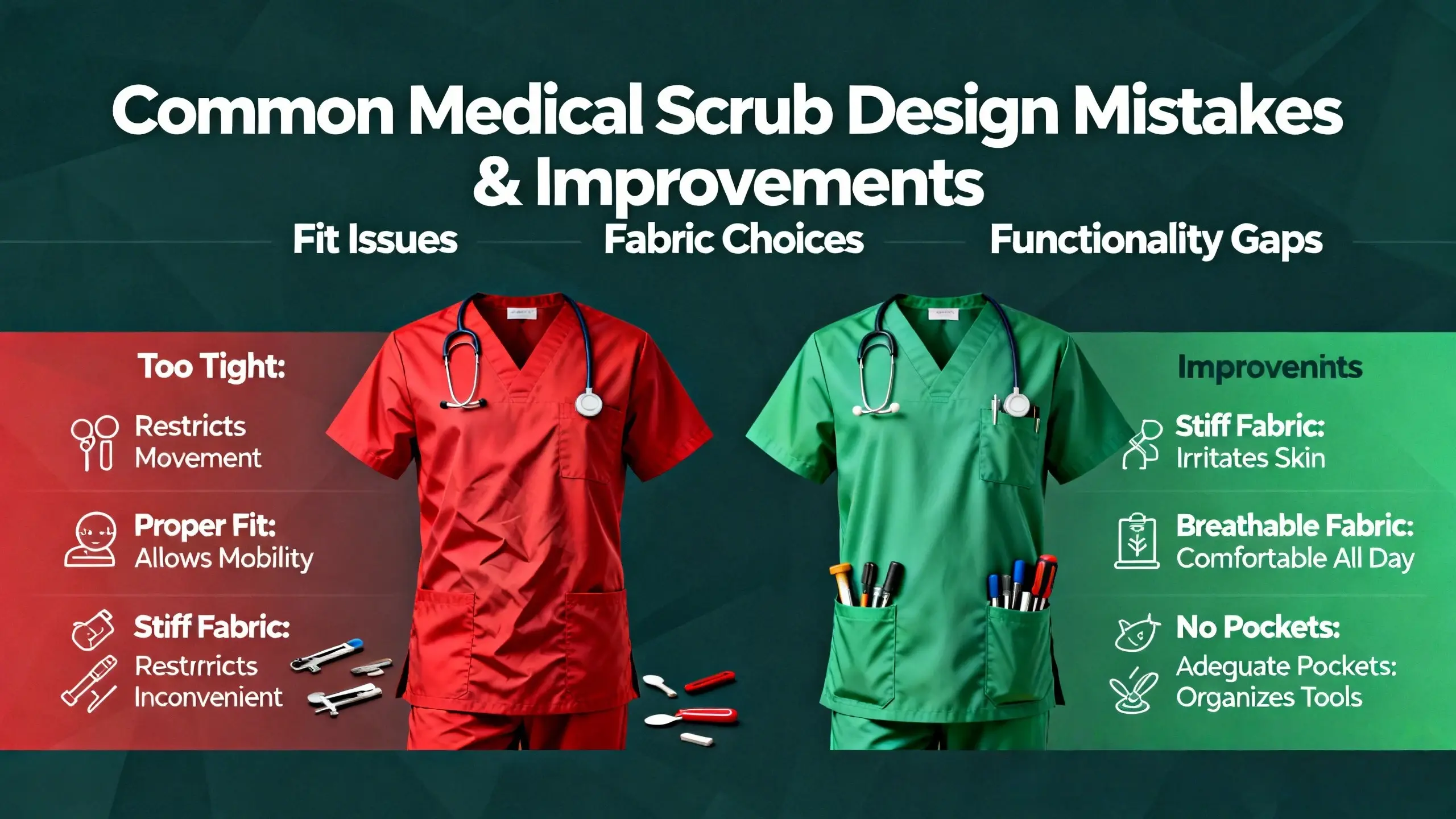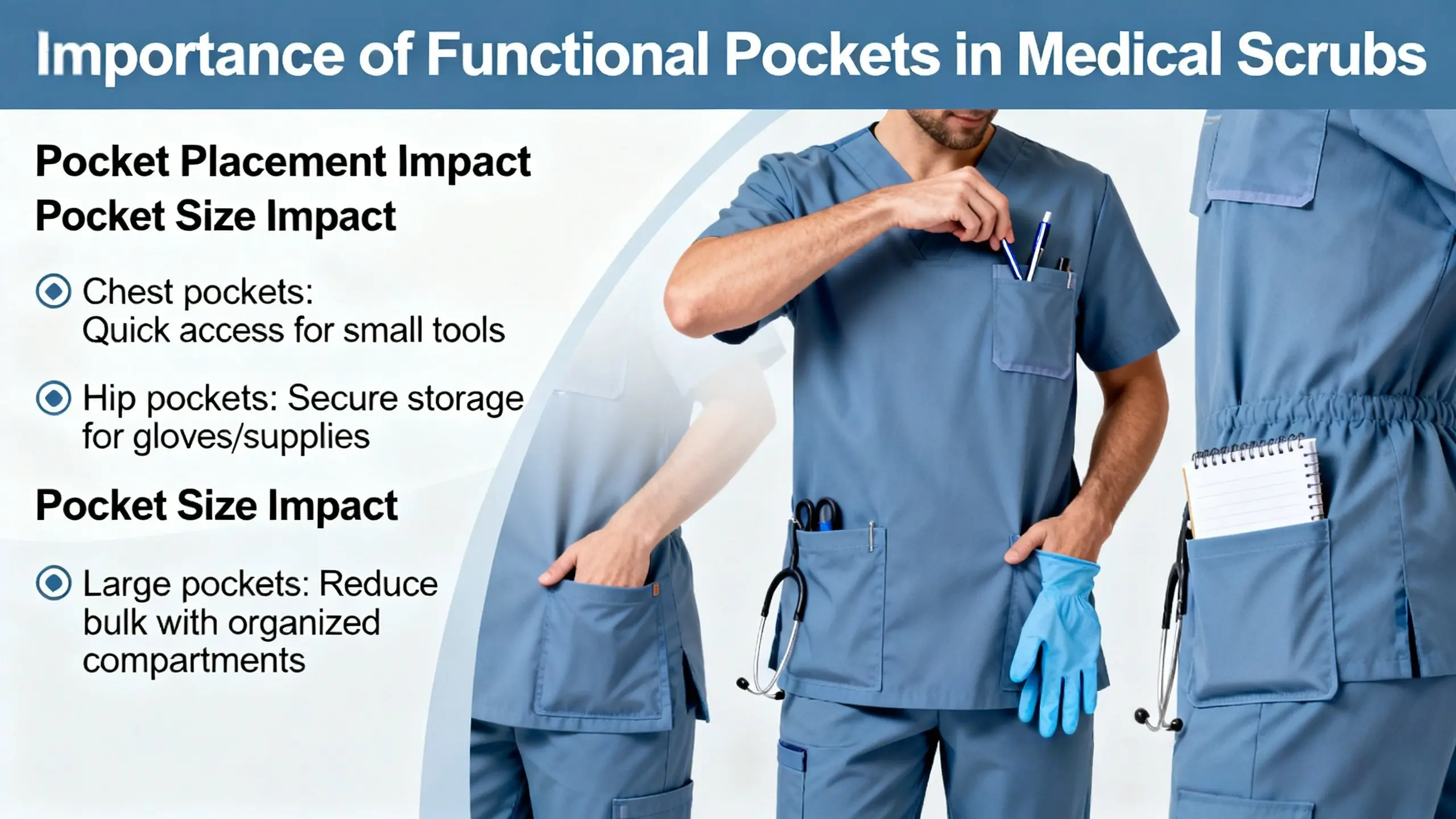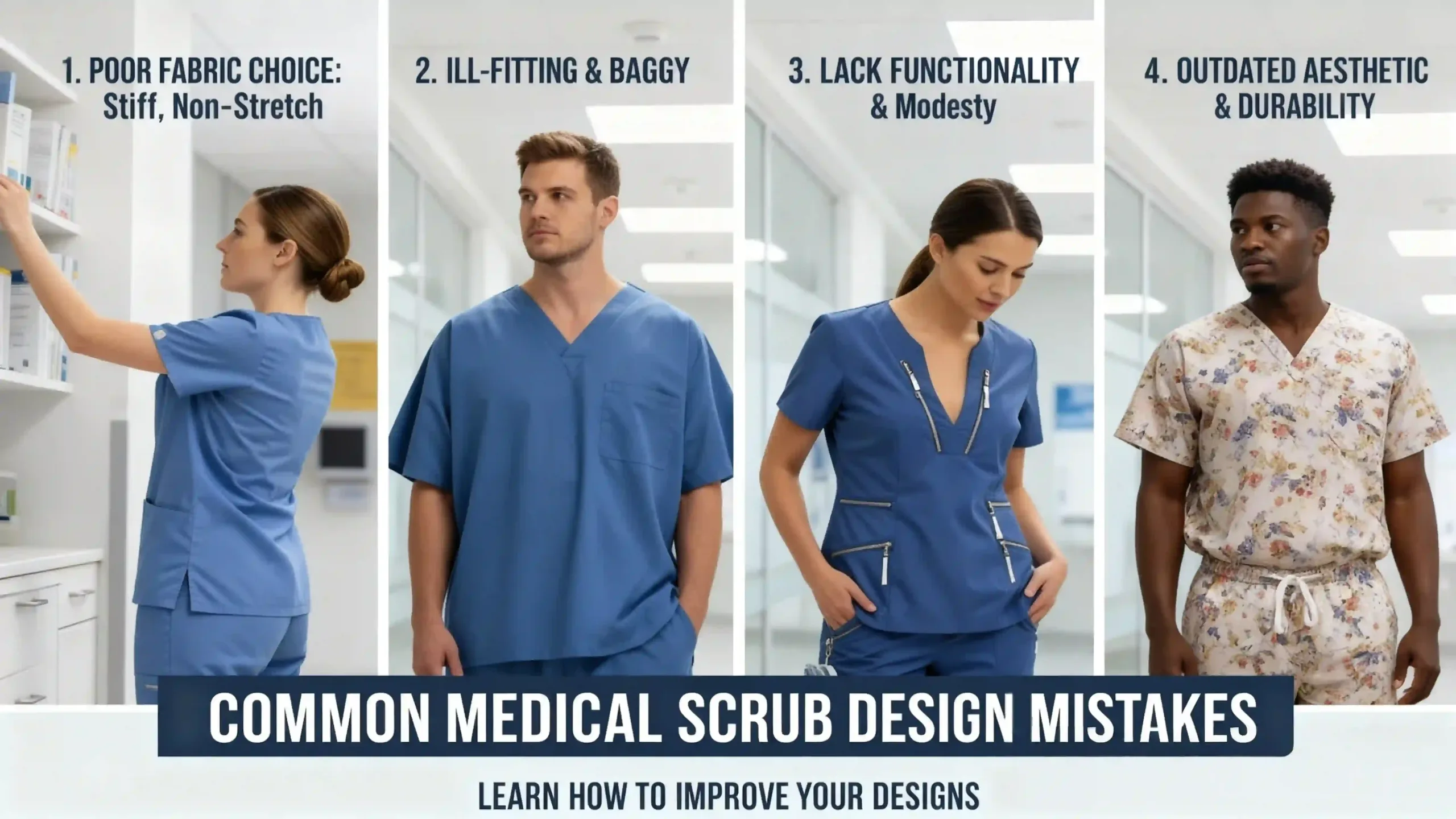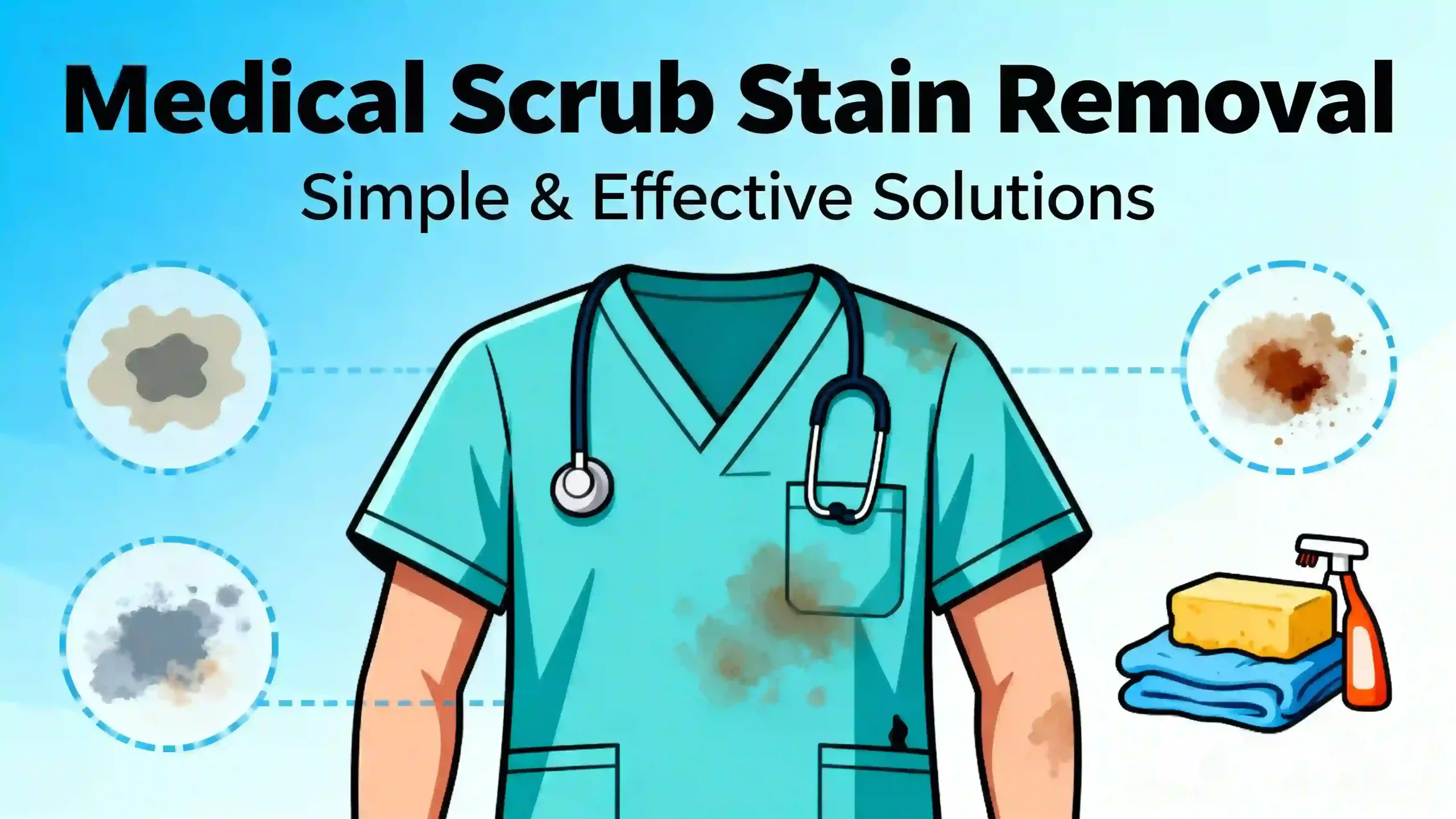Why Scrubs Design Mistakes Happen (and How to Fix Them)
Why Scrubs Design Mistakes Happen (and How to Fix Them)

Medical scrubs are an essential part of healthcare professionals’ daily uniforms. However, scrubs design mistakes are all too common. These errors can affect comfort, functionality, and performance in a high-stress environment. In this blog, we will discuss the common scrubs design mistakes made during manufacturing and how to fix them to ensure comfort and efficiency for healthcare professionals.
Common Scrubs Design Mistakes
Mistake #1: Ignoring Comfort in Scrubs Design
Comfort should be the foundation of any medical scrub design. Healthcare professionals spend long shifts in physically demanding environments, and uncomfortable scrubs can be a major distraction. Scrubs that are too tight or made from non-breathable materials can cause irritation and discomfort, which can reduce focus and performance.
Solution:
To ensure comfort, choose fabrics that are breathable, such as cotton blends or moisture-wicking materials. These fabrics help keep the body cool and dry. Additionally, incorporating ergonomic designs—like stretchable fabrics and side vents—allows for greater movement, which is crucial in a fast-paced healthcare setting.

Mistake #2: Choosing Poor Fabrics for Medical Scrubs
One of the most critical aspects of scrub design is fabric selection. Scrubs design mistakes often stem from choosing materials that are not durable, breathable, or easy to clean. Materials that don’t breathe properly can lead to discomfort and skin irritation, especially during long shifts.
Solution:
Choose fabrics that combine both durability and breathability. Poly-cotton blends are a popular choice, as they offer comfort and longevity. Fabrics with antimicrobial properties can reduce the spread of bacteria in medical settings. Additionally, consider wrinkle-resistant fabrics to maintain a professional appearance throughout the day.
Healthcare professionals require quick access to tools, personal items, and medical equipment during their shifts. Scrubs that lack sufficient and properly placed pockets can hinder efficiency, forcing workers to search for equipment or tools when they need them the most.
Mistake #3: Forgetting Functional Pockets in Scrubs Design
Solution:
Incorporate functional, well-placed pockets into the design. Ensure that pockets are deep enough to securely hold essential tools like pens, stethoscopes, or notepads. Consider adding hidden pockets or secure zippers to keep valuables, like phones or keys, safe. To learn how to create custom scrubs with multiple pockets and other features tailored to healthcare professionals, check out our article on How to Order Custom Scrubs: MOQ and Color Options.

Mistake #4: Not Considering Different Body Types in Scrubs Design
A “one-size-fits-all” approach to scrubs can be problematic. People come in all shapes and sizes, and a scrub that fits one person perfectly may not work well for another. Ill-fitting scrubs can cause discomfort, hinder movement, and negatively affect a healthcare worker’s appearance.
Solution:
Offer a variety of sizes and fits to accommodate different body types. Consider including options like petite, tall, and plus-size designs to ensure everyone can find a comfortable fit. Additionally, incorporate adjustable features such as waistbands and cuffs, which can help achieve a more tailored, custom fit. To learn more about choosing the right scrub colors and fits for various body types, check out our article on What Color Scrubs Do Different Healthcare Professionals Wear?.

Why These Scrubs Design Mistakes Matter
The scrubs design mistakes discussed above may seem minor, but they can have a significant impact on a healthcare worker’s performance. Uncomfortable or poorly fitting scrubs can distract workers, making it difficult for them to focus on the task at hand. When scrubs are not designed with comfort, functionality, and fit in mind, they can affect both the professional appearance and the overall efficiency of healthcare staff.
When scrubs are well-designed—comfortable, functional, and durable—they help healthcare professionals stay focused, perform at their best, and provide better care for their patients. A well-designed scrub can improve both the comfort and confidence of the wearer, which ultimately leads to a more productive and effective healthcare environment.
How to Fix Scrub Design Mistakes
To improve scrub designs and avoid the common mistakes discussed above, manufacturers should focus on creating products that are both stylish and functional. The best way to achieve this is by listening to feedback from healthcare professionals who wear scrubs every day. Their input is invaluable for understanding the practical needs and preferences of medical staff.
Key Fixes for Better Scrub Designs:
-
Comfort is Key: Choose breathable, flexible fabrics. Incorporate ergonomic features like side vents or stretch materials to ensure comfort and ease of movement.
-
Functionality Matters: Ensure that scrubs have plenty of pockets and that they are placed where they are easily accessible. Consider adding hidden or secure pockets for valuable items.
-
Fit and Adjustability: Design scrubs in a variety of sizes and fits to accommodate different body types. Offer adjustable features to allow for a more personalized fit.
By making these improvements, scrub manufacturers can provide better designs that meet the needs of healthcare professionals and improve their overall comfort and performance.
Frequently Asked Questions (FAQ)
What fabrics are best for medical scrubs?
The best fabrics for scrubs are those that are durable, breathable, and comfortable. Cotton blends are a popular choice, but fabrics with moisture-wicking or antimicrobial properties are also great options, especially in medical environments where hygiene is crucial.
What makes scrubs comfortable to wear?
The key to comfortable scrubs is choosing the right fabric and ensuring the fit is appropriate. Fabrics that stretch and breathe, combined with a good fit that allows freedom of movement, will keep healthcare professionals comfortable during long shifts.
Do scrubs have to be functional and stylish?
Yes! Many modern scrub designs offer both functionality and style. Designers are now creating scrubs that look good while maintaining essential features, such as multiple pockets and easy-to-move fabric.
How often should scrubs be replaced?
Scrubs should be replaced regularly—every 6-12 months—depending on the level of wear and tear. Frequent washing, exposure to harsh medical environments, and fabric degradation over time can all contribute to the need for replacement.
Designing Scrubs That Support Healthcare Professionals
The design of medical scrubs is more than just about appearance—it directly impacts the comfort, efficiency, and well-being of healthcare professionals. By addressing common scrubs design mistakes, such as poor fabric choices, ill-fitting cuts, and lack of functionality, manufacturers can create scrubs that truly support those who rely on them every day.
When healthcare workers have access to well-designed, comfortable, and functional scrubs, they can focus on what matters most—providing excellent care to their patients. With an emphasis on the right fabrics, ergonomic designs, and practical features like functional pockets and adjustable fits, the next generation of scrubs will empower healthcare professionals to perform at their best, all while staying comfortable and confident.
As the demands of healthcare continue to evolve, it’s important that scrub designs do the same. With thoughtful innovation, we can ensure that the attire healthcare professionals wear enhances their performance, rather than holding them back.
Contact Us Now>>>Contact Us
Learn more about us>>>LANO SCRUB MANUFACTURER










